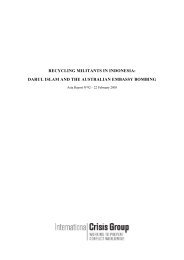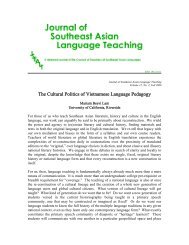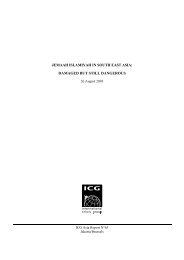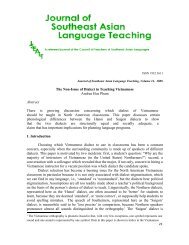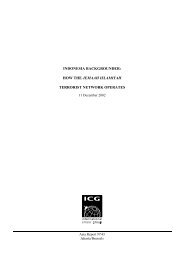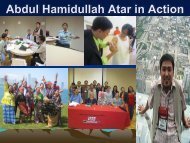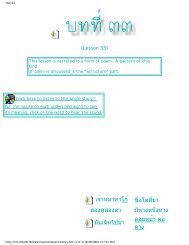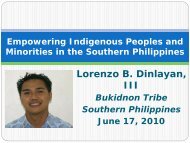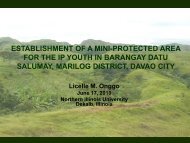Introduction - SEAsite - Northern Illinois University
Introduction - SEAsite - Northern Illinois University
Introduction - SEAsite - Northern Illinois University
Create successful ePaper yourself
Turn your PDF publications into a flip-book with our unique Google optimized e-Paper software.
Prentation Abstracts<br />
total population of the country, and sought their political support. Therefore, the<br />
Khmu, the Hmong, the Mien and other ethnic groups who for centuries had been<br />
considered as “pariah” or foreigners by the dominant society in Laos, actively participated<br />
on both sides, that of the Royal Lao Government and that of the Neo Lao<br />
Hak Xat (Pathet Lao), in the long and devastating civil war of Laos (1946-1975).<br />
The Hmong involvement in the first and second wars of Indochina would<br />
constitute an example. To show their loyalty to the King of Laos, Touby Lyfoung<br />
led a faction of the Hmong to support the Royal Lao Government while his maternal<br />
uncle Faydang Lobliayao led another faction to join the Lao Issara Movement<br />
or Pathet Lao under the leadership of Prince Souphanouvong. The Hmong distinguished<br />
themselves in the defense of the “national cause” with General Vang Pao<br />
from the Royal Lao Army’s side and with Colonel Ya Thao Tou on the side of the<br />
Army of National Liberation.<br />
Today, thirty years after the Vietnam War ended in 1975, the geopolitical<br />
world has been profoundly changed. The great powers, such as the U.S.A., the<br />
USSR and China, who only yesterday were enemies, have become friends today<br />
under a new era of cooperation and partnership. The Laotian leaders who were<br />
belligerents during the civil war should take their example into consideration to<br />
promote peace and national reconciliation which constitute the essential foundation<br />
for social and economic progress in Laos.<br />
Maria Carmen Domingo-Kirk, Ed.D.<br />
Laos 1965 - Feminist Consciousness and Social Critique<br />
Anthropology Instructor, Department of Philippine Studies,<br />
City College of San Francisco, California<br />
This paper focuses on the experience of an educator and medical records<br />
librarian who joined a Filipino medical organization, Operation Brotherhood International<br />
(OBI) a humanitarian organization based in Manila, Philippines. Volunteers<br />
of this organization sign up for a two year contract which can be renewed<br />
more than once for service in Laos.<br />
Forty years beyond the Indochinese War, the author reflects on her one year<br />
work in Laos. First, as an educator who had the task of supervising kindergarten<br />
classes in Vientiane at the refugee center within the That Luang complex and at<br />
the clinics operated by the OBI in Vang Vieng, Sayaboury, Paksong and Attopeu.<br />
Second, as a medical records librarian who kept track of the diseases reported at<br />
the OBI hospital in Vientiane and in the clinics in the countryside.<br />
After eleven months of service, the author became conscious of the reality<br />
of the war going on in Laos. After much reflection, she questioned many things<br />
that were going on. The deaths of a Filipina nurse, a Canadian with the International<br />
Control Commission, a young Australian diplomat, three American pilots,<br />
all these deaths affected the author deeply. Then there is the quiet resignation of<br />
young Lao soldiers who were brought to the hospital in Vientiane as their arms and<br />
legs were amputated.<br />
The author left Laos after a year with bitter memories of what a war can<br />
do. The last forty years has made her a critic of armed conflict. War has happened<br />
before, continues to happen now and most likely will happen in the future. As a<br />
woman and a social scientist the author critiques those who start wars and those<br />
who aid those engaged in this inhuman, human activity.<br />
Valerie Dzubur, RN MSN FNP-C<br />
Development Practice in Primary Health Care: A Participatory<br />
Service and Education Model in Lao<br />
Samuel Merritt College, Oakland, California<br />
The provision of primary health care is basic to all societies. Although taken<br />
for granted in industrial and post-industrial nations, it is not uncommon to visit<br />
many localities where people with health needs remain un-served. There is increasing<br />
recognition among Lao people that good health is critical to appropriate<br />
development. Furthermore, where resources are scarce, service teams can work<br />
with local people to meet needs in creative ways. The main point of this paper<br />
is to demonstrate that health care needs can be taught and administered without<br />
prolonged development implementation and/or extensive funding. Moreover, in<br />
this case, international health care providers collaborate with local practitioners to<br />
create conditions that can meet health needs in both an educative and applied manner.<br />
In this participatory service model, a minimal infrastructure was identified<br />
and used with partners to create the requisite conditions for education and service.<br />
Examples are drawn from work with a local free Sunday clinic in Vientiane and an<br />
orphanage in Luang Phrabang.<br />
N. J. Enfield, Ph.D.<br />
Language in Laos: an Agenda for Research<br />
Language and Cognition Group, Max Planck Institute for Psycholinguistics,<br />
The Netherlands<br />
There is at present a vigorous public debate in Laos on the issue of language,<br />
with the participation of scholars, researchers, educators, and politicians.<br />
This debate goes to the highest level, and has been on the agenda for decades. The<br />
issue? Whether the letter ‘r’ should or should not be included in the Lao alphabet.<br />
Meanwhile, there are nearly one hundred distinct human languages spoken in<br />
Laos which are in danger of extinction in the immediate or near future. We know<br />
little or nothing about the structure, history, or social setting of these languages<br />
or the people who speak them. There is no public debate about this issue in Laos,<br />
and next to no research activity to document the country’s dozens of minority<br />
languages, whether for scientific, practical, or social purposes. This paper offers a<br />
number of reasons why this must change.<br />
Grant Evans, Ph.D.<br />
Tiao Phetsarath and the Lao Issara<br />
Reader in Anthropology, Centre for Anthropological Research,<br />
Department of Sociology, <strong>University</strong> of Hong Kong, Hong Kong, PRC<br />
Tiao Phetsarath was one of the most important figures in 20th century Lao<br />
nationalism. His leadership of the small Lao independence movement, the Lao<br />
Issara, from 1945-1949 brought him both notoriety and political prominence, but<br />
it also brought him into conflict with the Luang Phrabang monarchy which he had<br />
long supported. His motives for some were suspect. The disagreement between<br />
Phetsarath and the King would deprive Laos of one of its most important figures as<br />
it made the transition to independence and fell into the cauldron of the Cold War.<br />
The confusing events around the Issara movement also fragmented the country’s<br />
political memory, and continues to do so today.<br />
Wouter Feldberg, MA<br />
Gerrit Wuijsthoff’s Journey to the Lao Court at<br />
Vientiane, 1641-1642<br />
International Institute for Asian Studies (IIAS), Leiden and Amsterdam,<br />
the Netherlands<br />
In July 1641 the Dutch United East India Company (VOC) merchant Gerrit<br />
Wuijsthoff set out from Loveck, the capital of Cambodia, for a journey up the<br />
Mekong River. His destiny was the Lao court at Vientiane. Wuijsthoff was sent to<br />
the Lao King Souligna Vongsa by VOC Governor General Antonio van Diemen of<br />
Batavia, who was in search of new trading opportunities. While making his way<br />
up and down the Mekong River Wuijsthoff made valuable notes of his experiences<br />
with the Lao, their country, and king. In doing so he was the first European to write<br />
an elaborate report on Laos and this river route. Wuijsthoff and the Portuguese<br />
Jesuit missionary Giovanni-Maria Leria authored the only extensive European accounts<br />
of Laos until the French appeared in the region two centuries later.<br />
The journal of Gerrit Wuijsthoff can still be read in the VOC section of<br />
the National Archives in The Hague, the Netherlands. It is a unique European<br />
source of information on seventeenth century Laos. By describing a number of<br />
Wuijsthoff’s experiences, this paper will address seventeenth century Lao customs,<br />
trade, the monarchy, politics, and attitude towards European traders.<br />
Penélope V. Flores<br />
Intercountry Cultural Contact and Exchange:<br />
The Philippine-Lao Nexus<br />
San Francisco State <strong>University</strong>, California<br />
In 2004, The Mekong Circle International initiated a book project where Filipinos<br />
who served in Laos told their stories for publication. There was a huge response<br />
for the call for personal stories. The first work of Filipinos in Laos existed<br />
in the field of humanitarian and socioeconomic fields represented by Operation<br />
Brotherhood, a private Jaycee (Junior Chamber of Commerce) organization. By<br />
the 1960s the population of the Filipino community in Laos increased and many<br />
Filipinos served under USAID and many affiliated corporations.<br />
This paper is a content analysis of the personal stories told by Filipinos who<br />
served in Laos from 1956 to 1973. Using the ethnographic strategies of Emic






